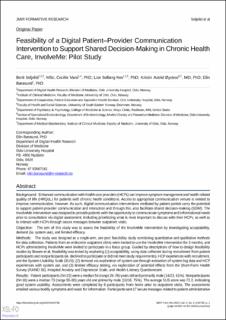| dc.contributor.author | Seljelid, Berit | |
| dc.contributor.author | Varsi, Cecilie | |
| dc.contributor.author | Solberg Nes, Lise | |
| dc.contributor.author | Øystese, Kristin Astrid Berland | |
| dc.contributor.author | Børøsund, Elin | |
| dc.date.accessioned | 2022-09-16T10:47:08Z | |
| dc.date.available | 2022-09-16T10:47:08Z | |
| dc.date.created | 2022-05-14T12:14:55Z | |
| dc.date.issued | 2022 | |
| dc.identifier.citation | Seljelid, B., Varsi, C., Solberg Nes, L., Øystese, K. A. & Børøsund, E. (2022). Feasibility of a Digital Patient–Provider Communication Intervention to Support Shared Decision-Making in Chronic Health Care, InvolveMe: Pilot Study. JMIR Formative Research, 6(4), Artikkel e34738. | en_US |
| dc.identifier.issn | 2561-326X | |
| dc.identifier.uri | https://hdl.handle.net/11250/3018406 | |
| dc.description.abstract | Background: Enhanced communication with health care providers (HCPs) can improve symptom management and health-related quality of life (HRQoL) for patients with chronic health conditions. Access to appropriate communication venues is needed to improve communication, however. As such, digital communication interventions mediated by patient portals carry the potential to support patient-provider communication and interaction and through this, also facilitate shared decision-making (SDM). The InvolveMe intervention was designed to provide patients with the opportunity to communicate symptoms and informational needs prior to consultation via digital assessment, including prioritizing what is most important to discuss with their HCPs, as well as to interact with HCPs through secure messages between outpatient visits.
Objective: The aim of this study was to assess the feasibility of the InvolveMe intervention by investigating acceptability, demand (ie, system use), and limited efficacy.
Methods: The study was designed as a single-arm, pre-post feasibility study combining quantitative and qualitative methods for data collection. Patients from an endocrine outpatient clinic were invited to use the InvolveMe intervention for 3 months, and HCPs administering InvolveMe were invited to participate in a focus group. Guided by descriptions of how to design feasibility studies by Bowen et al, feasibility was tested by exploring (1) acceptability, using data collected during recruitment from patient participants and nonparticipants (ie, declined to participate or did not meet study requirements), HCP experiences with recruitment, and the System Usability Scale (SUS); (2) demand via exploration of system use through extraction of system log data and HCP experiences with system use; and (3) limited efficacy testing, via exploration of potential effects from the Short-Form Health Survey (RAND 36), Hospital Anxiety and Depression Scale, and Health Literacy Questionnaire.
Results: Patient participants (N=23) were a median 54 (range 26-78) years old and primarily male (14/23, 61%). Nonparticipants (N=16) were a median 73 (range 55-80) years old and primarily male (12/16, 75%). The average SUS score was 72.2, indicating good system usability. Assessments were completed by 8 participants from home prior to outpatient visits. The assessments entailed various bodily symptoms and needs for information. Participants sent 17 secure messages related to patient administrative matters, symptoms, and challenges. Focus group participants (N=4) were all female and registered nurses. Data were analyzed in 2 predefined themes: Acceptability and Demand. Acceptability included the subthemes intervention attractiveness and intervention suitability. Demand included the subthemes elements of SDM and intervention challenges and opportunities. All patient participants completed outcome measures at baseline, and 19 (19/23, 83%) completed outcome measures at 3 months. These preliminary efficacy findings were mixed and inconclusive.
Conclusions: The study design provided findings from both patient and HCP perspectives and supported feasibility of the InvolveMe intervention. The investigation of acceptability and demand supported the potential for remote SDM mediated by patient portals using assessments and secure messages. | en_US |
| dc.language.iso | eng | en_US |
| dc.rights | Navngivelse 4.0 Internasjonal | * |
| dc.rights.uri | http://creativecommons.org/licenses/by/4.0/deed.no | * |
| dc.title | Feasibility of a Digital Patient–Provider Communication Intervention to Support Shared Decision-Making in Chronic Health Care, InvolveMe: Pilot Study | en_US |
| dc.type | Peer reviewed | en_US |
| dc.type | Journal article | en_US |
| dc.description.version | publishedVersion | en_US |
| dc.rights.holder | © Berit Seljelid, Cecilie Varsi, Lise Solberg Nes, Kristin Astrid Øystese, Elin Børøsund. | en_US |
| dc.source.pagenumber | 1-17 | en_US |
| dc.source.volume | 6 | en_US |
| dc.source.journal | JMIR Formative Research | en_US |
| dc.source.issue | 4 | en_US |
| dc.identifier.doi | https://doi.org/10.2196/34738 | |
| dc.identifier.cristin | 2024568 | |
| dc.relation.project | Norsk sykepleierforbund: 847382 | en_US |
| dc.source.articlenumber | e34738 | en_US |
| cristin.ispublished | true | |
| cristin.fulltext | original | |
| cristin.qualitycode | 1 | |

